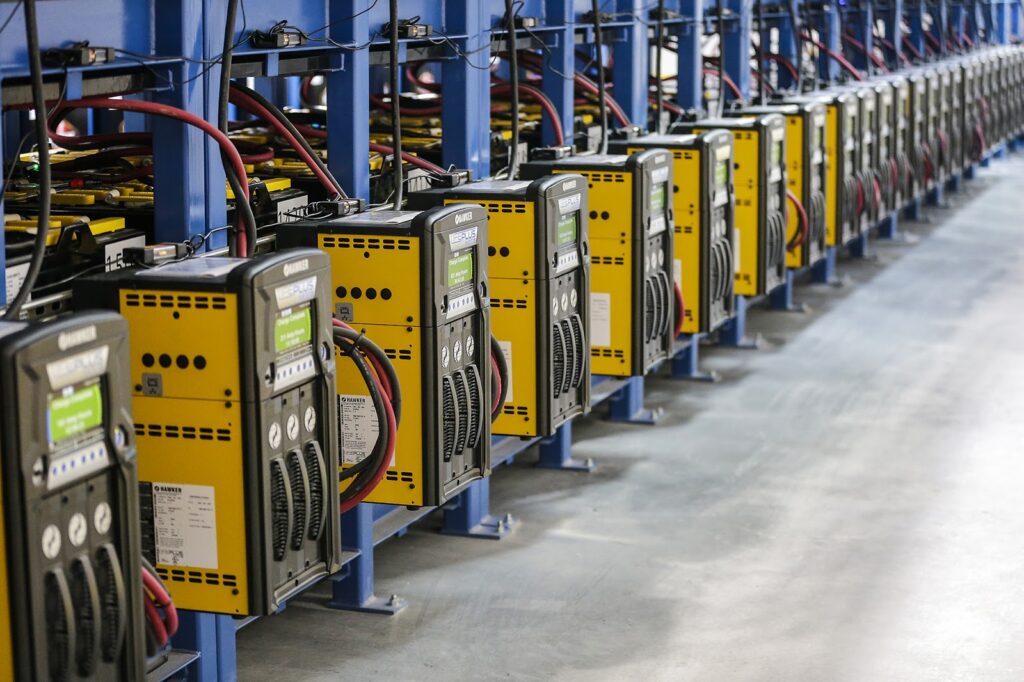Over 60% of the Forklift Market is Electric Vehicles… and for Good Reason!
A drive to meet lower emissions standards has steered more warehouse and manufacturing operations to rely on electric forklifts over internal combustion vehicles. Electric vehicles now represent over 60% of the forklift market. Besides a reduced carbon footprint with zero emissions, electric forklifts are often preferred because they operate with a significantly reduced noise level. They are also smaller which makes them ideal for narrow aisles and tight spaces. The combination of benefits provides a safer, more environmentally friendly, and cost-effective option, particularly for indoor operations.
If you’re considering plugging into the electric forklift market, it’s wise to learn all you can before making that purchase. The Apex team is a leading provider of electric forklift vehicles and we are here to help you find the right solution for your facility.
Take a look at some of the most Frequently Asked Questions that we receive particularly regarding electric forklift batteries and chargers.

Electric Forklifts – Batteries & Chargers FAQs
1. How long does it take to charge an electric forklift battery? Charging times will depend on the capacity of the battery, amperage of the charger, and the remaining battery charge. Typically, most electric forklift batteries take eight hours to fully charge, however, it is recommended to follow the 8-8-8 Rule: 8 hours of operation, 8 hours of charging, and 8 hours of cooling. This will maximize battery life. Also, only charge when the remaining capacity is <40% as batteries have a limited number of charge cycles, and excess charging will reduce battery life.
2. How often should I replace my forklift battery? A well-maintained lead-acid forklift battery can last over 10 years. Replace your battery when it no longer holds a charge, requires recharge frequently following low usage, has corrosion on the battery case or has a sulfuric odor. If the battery smokes during use or charging, replace it immediately.
3. How much does a new forklift battery cost? The answer to this question depends on the type of forklift. Typically, the cost of a new battery is around a third of the total cost of the forklift. Proper maintenance, reconditioning or repair should be your first option.
4. Do I need water in my forklift battery? Yes, you do. The water level should be checked about every 10 charge cycles. This check should be done after the charge cycle is complete. If water is needed, use an approved solution or distilled water; not standard tap water which contains elements that decrease battery performance/life. Be careful not to overfill as it can lead to spillage and dangerous sulfuric acid skin burns.
5. How much space do I need to charge my forklift? You typically will not need any space larger than your forklift to charge it each day, but it should be in a clearly marked area protected from other forklift traffic.
6. How do I know I’m choosing the right charger? Choose a battery charger recommended by the manufacturer for your specific forklift. The charger is dependent on the battery voltage (eg. 24, 36, 48, 72, 80V) and desired output in Amp-Hrs which should be within 10% of the battery’s rating to ensure a full charge during the planned charge time.
7. How do I transport forklift batteries? Typical forklift batteries are between 1,000 and 4,000 pounds. As always, safety first! Ensure personnel have proper PPE and training before transporting. Battery lift points should be inspected for damage and corrosion and lift equipment used should be within the rated lift capacity. Batteries should also be properly secured to avoid any spillage during movement. Transportation of batteries should be left to a trained and experienced professional.
8. How do I charge a forklift battery? Make sure that the battery and charger outputs are compatible and that the charger cables are in appropriate working condition; not damaged or cracked. Ensure the forklift is located in the proper charging location away from aisle traffic with the key off and brake applied, or wheels chocked. While wearing the appropriate PPE, plug the charger into the charging connector and initialize the charge cycle. If anything unusual occurs such as smoke, excessive sparks or smells, disconnect and contact someone for service. Once the charge is complete, disconnect and check battery water levels if indicated based on the battery logbook. Add water as needed to the battery after it has charged and cooled down.
9. Who should charge forklift batteries? Inspections, maintenance, repair and charging of your forklift battery should be conducted by a trained and experienced professional. Do not let your staff attempt to change or charge your forklift batteries if they have not had proper training and instruction.
10. What safety conditions do I need for my charging area? OSHA has established clear safety recommendations for forklift battery charging areas including adequate ventilation to disperse hydrogen vapors, fire protection or fire extinguisher, an eyewash station, warning/No Smoking signs and acid neutralization materials in the immediate area. Consult the OSHA site for more information: https://www.osha.gov/SLTC/etools/pit/forklift/electric.html.
Plug In with Apex Parts & Service Team
The Apex team is committed to helping you in every aspect of your forklift battery and charging needs. We provide comprehensive inspection as well as a full suite of batteries and chargers when it comes time to replace either one. We also carry a variety of brands. Contact Apex today!
